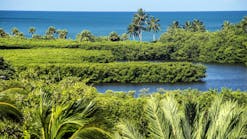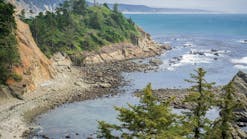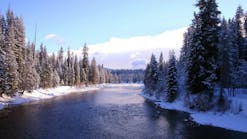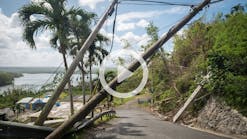When building retaining walls, the initial considerations are always practical. The finished wall needs to be strong; it must have integrity, whatever its height; it should offer ease and speed of application; and it must do the job for which it’s intended. The result: a tough wall for a tough job.
But there’s more to life than just utility–everyone knows beauty counts. As applications for retaining walls grow, creating more usable space for residential and commercial projects, builders and clients are demanding greater variety. Taking that into consideration, many manufacturers of segmental blocks have added variations to their products’ shapes and colors. Blocks with textured rather than flat fronts add visual interest and look more like natural stone. Coloring blocks was a further move toward the natural, the unobtrusive. Certainly a reddish block would blend into a Georgia red clay hillside better than a gray block would.
Anchor Wall Systems of Minnetonka, MN, offers five block configurations–Windsor Stone, Diamond, Diamond Pro, Vertica, and Vertica Pro–that feature a textured face. The blocks are available in colors ranging from Buff (sandstone), Pewter (light gray), and Charcoal (darker gray) to (brick) Red and Terracotta. Local distributors can also match color samples to create a retaining wall block that blends in with a specific landscape or soil color.
Local distributors and manufacturers for Keystone Retaining Walls of Bloomington, MN, create the colors specified for each local region. Keystone’s textured-face block line includes structural units (Standard, Compac, and Mini/Cap) and landscape units. The landscape line includes not only the beveled-face Garden Wall, Legacy Stone, and Sedona Stone, but also the chiseled-face Regal Stone and the Arbor Stone Planter, which, as the name suggests, will accommodate decorative plantings inside the block.
Grapevine, TX’s Pavestone/HydroPave Ltd., which has a partnership with Anchor Wall Systems, also distributes the plantable Alpenstein Botanical Wall. Pavestone’s own Rumbled Wall block creates an “old stone” wall that looks like it’s been transplanted from the English countryside.
Is It Stone, or Is It Boulderscape?
Segmental retaining walls aren’t the only ones concerned with appearances. Boulderscape of Capistrano Beach, CA, takes another step closer to nature in constructing soil nail walls, using a top-down construction to create a wall and facing it with shotcrete. The wall face is then sculpted to look like worn sandstone, fieldstone, or cracked granite. “We can also do shale, to a point,” says Boulderscape’s Steve Jimenez, “although that’s very expensive.”
The thickness of the shotcrete varies from 8 to about 24 in. thick, depending on the application. Because of this variance and the hand-crafted nature of the project, a Boulderscape retaining wall is more expensive than a concrete-block wall. Many of the company’s projects involve creating natural-looking settings in zoos and at affluent residential sites.
“If you want lowest cost, go with the concrete blocks,” Jimenez advises. “But even a cost-conscious customer like Caltrans [the California Department of Transportation] will use our product when looks count. In a city setting, Caltrans will use block walls. However, for hillsides, valleys, national parks, and the like, they will use us.”
Boulderscape walls are often used on roadsides. Jimenez mentions projects on California’s Route 101, on Route 92 near Half Moon Bay in San Francisco, and on Route 110 below Dodger Stadium in Los Angeles. “Our wall under the Getty Center [in Los Angeles] is the Boulderscape ‘most viewed every day,'” he adds.
In keeping with the natural look, Boulderscape walls usually include vegetation as well. “Vegetation is planted at the wall bottom or top, or we can install planter pockets,” Jimenez explains. “To create these planter pockets, before construction we’ll install a 4-inch-diameter PVC pipe into the hillside, then build the retaining wall around that. The tubes are filled with a planting mix, and a drip line comes down the pipes. We use drought-tolerant plants or vines, such as creeping fig or ivy. We don’t want to cover the entire wall–the plants are just for aesthetics.”
Does vegetation limit the use or increase the cost of the wall? “Vegetation never takes away from a wall; it’s always best to blend the wall in by covering parts of it with vegetation. That makes it look even more natural. The drainage needed for plants doesn’t add cost, because all retaining walls have drainage behind them,” Jimenez reports.
Concrete and Plants Do Mix
Vegetation can also make a block retaining wall aesthetically pleasing. Many walls are topped with hanging or trailing plants, and manufacturers produce blocks that can contain plantings, such as Keystone’s Arbor Stone Planter or Pavestone’s Alpenstein Botanical Wall.
In creating its Verdura (named for VERDant green, and DURAble) “plantable” retaining walls, Soil Retention Products of Oceanside, CA, fully intended for its customers to use vegetation as an integral part of the retaining wall, whether the structure is a planter bed or a 60-ft.-high wall. “Does vegetation give our Verdura walls any limitations? I don’t think so,” believes Soil Retention Products’s Dean Sandry. “Everyone would rather have a green, growing structure than more concrete. In our service area–southern California, Arizona, and Nevada–we can plant a wall of greenery year-round. We usually plant rosemary, ivy, or flowering vines in the walls. Soil and moisture is continuous in our wall; the cement’s heat absorption doesn’t dry the plants out.”
A plantable wall has no special drainage considerations, states Sandry. “It uses the standard drainage you’d use with any concrete wall. We recommend irrigating, sprinkling up to the wall, or a drip system from the top. But we advise people to not put big water lines on top of the wall; when they break, and they will break, it’s not a good idea to have all that water on the wall.”
Plant roots and soil chemistry don’t pose a problem either. “Roots probably enhance the wall system,” notes Sandry. “The roots become like a miniature support system that helps hold the backfill. Because the wall is planted, we use soil and fertilizer at the base of the wall as backfill. Behind the wall, we use geogrid.”
Planting in the Field
The Orange County Division of Standard Pacific Homes has used Verdura on a number of projects. “It gives us the ability to maximize a site and maximize the flat pad area on hillside projects,” points out Bob Roper, Standard Pacific’s corporate director of land development. “We’ve always used the blocks that are plantable–that’s what we like about them. It gives the area a softer look than other products. We also like the exposed aggregate finish.”
Roper sees no tradeoffs in using plantable rather than closed blocks. “It enhances the site. The key is that the wall goes in when you are rough-grading a project, which does not inhibit the process. It goes in quickly. Soil Retention Products modified logging equipment to help move the blocks, some weighing up to 120 pounds, which makes the process faster.”
Standard Pacific Homes ensures that its walls have proper drainage, not only to protect the integrity of the wall but also to keep the plantings healthy. “If the wall is over 3 feet, we install ‘burrito drains’–which is a local term; they’re basically French drains–in which we install a 4-inch perforated pipe, 1 to 3 feet of gravel, and filter fabric,” Roper explains. “Depending on soil conditions, sometimes we need to put select gravel behind the blocks. Of course, if there are sheer-angle considerations that need to be addressed, or fault lines, we’ll consult with geotechnical experts.”
According to Roper, Orange County considers these structures “reinforced slopes,” rather than retaining walls, because they are flexible. These flexible walls prove very stable, however. “In the six or seven years we’ve been using these walls, they have performed excellently, with zero ‘go-backs,'” Roper reports.
Roper offers more detail on installation: “For a wall over 3 feet, with a common area, we put a ‘V’ ditch of colored concrete atop the walls. We irrigate right on the face of the wall, using brown line, UV-resistant pipe. We then vegetate the wall itself, at the top of the wall between its face and the V ditch, and the slope over the ditch. We plant primarily vinca, but also rosemary. Over a period of years, generally three or four, the walls will be completely overgrown.”
According to Roper, vinca and rosemary roots don’t harm the wall in any way. “They’re shallow-rooted; if anything, they help the wall,” he maintains. “One thing, though: Until the wall is pretty much covered with vegetation, we need to have a vector-control program in place that prevents critters–ground squirrels, generally–from getting into the wall.”
If the slope is somewhat rocky and contains boulders, Standard Pacific Homes will usually create a back cut and sometimes a buttress for the wall, depending on the site’s soil conditions and the wall’s height. “We only use geogrids because it’s basically a gravity wall,” Roper explains. “Certain times the geogrids will extend into people’s lots, and we have to advise them not to dig into those areas.”
Since the retaining walls allow homes “at a height,” Standard Pacific Homes places some sort of safety barrier atop the walls. “We usually use the Caltrans B11-47 standard, a freestanding rail attached to galvanized posts, with an 8-inch center, strung with two horizontal cables. We also paint the posts to match surrounding vegetation. Of course, too, the homeowners’ lots end at the top of slope, at least a few feet from the wall,” Roper adds.
“We’re the contractors who make the residential areas and use these for utility walls, but we’re also training landscapers to use this system for more ‘in-yard’ applications,” he says.
The Sound Barrier
Vegetated walls have one more benefit. The congestion of many urban and suburban areas often means that traffic-clogged roadways and residential areas are placed cheek-by-jowl. If retaining walls are used in such areas, the walls not only solve slope-retention and erosion problems, they can also cause or increase noise pollution; concrete, like all hard surfaces, reflects, moves, and sometimes amplifies sound.
Realizing this potential problem, some communities also erect berms or wooden sound walls or plant a stand of evergreen trees to help reduce noise. Vegetated walls, however, can serve double duty, acting as both a sound deadener and a soil retainer.






